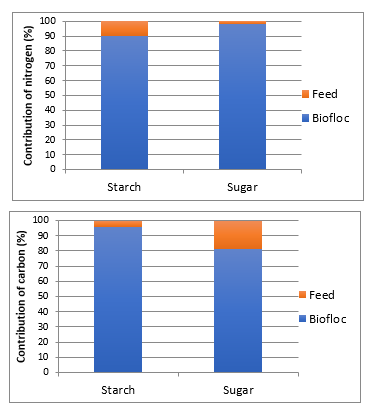NUTRITIONAL CONTRIBUTION OF BIOFLOC TO BLUEGILL Lepomis macrochirus AND IMPORTANCE OF UNINTERUPPTED AERATION IN BIOFLOC SYSTEMS
Bluegill is a popular sportfish in Arkansas and food fish throughout the world . They are mostly cultured in earthen ponds where they consume various zooplankton and insects . There is interest in year round production, but in more temperate areas, this must be done indoors where complete diets must be provided . While this may increase feeding cost, i t may be possible that bioflocs can provide supplemental nutrition to bluegills, but this has not yet been established.
In this study, three treatments were compared; a clearwater flow through control; biofloc technology with corn starch (BFT-Sta) or biofloc technology with sugar (BFT-Sug). The carbon sources were added at carbon to nitrogen ratio of 15. The bluegill juveniles (5.3 g) were cultured in 100L circular tanks and were fed to apparent satiation twice daily for 32 days. Over 32 days, water quality was measured, and the bacterial composition was identified on the final day. T he survival, growth, hepatosomatic index, liver histology and isotope analysis were performed.
Ammonia-N was significantly lower in the control (0.23 mg/l), but the mean ammonia levels in the BFT treatments (0.57-0.69 mg/l) were within safe levels for bluegill. However, on day 22 there was unusually high rainfall and subsequent flooding that tripped the electrical fuse and caused a temporary stoppage to the aeration. This led to dissolved oxygen reaching 0.2 mg/l in the BFT treatments compared to 5.5 mg/l in the control. The aeration stoppage also caused an ammonia spike of around 1.5 mg/l in the BFT treatments compared to 0.3 mg/l ammonia in the control . This water quality deterioration caused survival dropping to 63 and 65% in the BFT-Sta and BFT-Sug, respectively, whereas survival in the control was 98%. It was also noticed that feed intake was lower in the BFT treatments, before and after the aeration stoppage.
These findings indicate that biofloc conditions may not be optimal for bluegill; however, there was evidence bluegill obtained some nutrition from the bioflocs. Moreover, the carbon source influenced the contribution of carbon and nitrogen. Significantly more nitrogen and carbon were obtained from bioflocs produced from corn starch and sugar, respectively. This may indicate differences in the nutritional composition of the bioflocs.
